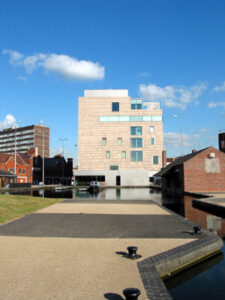
Contents
About Walsall
Walsall is a market town and administrative centre in West Midlands County, England. Historically part of Staffordshire, it is located 9 miles (14 km) north-west of Birmingham, 7 miles (11 km) east of Wolverhampton and 9 miles (14 km) from Lichfield.
Walsall is the administrative centre of the wider Metropolitan Borough of Walsall. At the 2011 census, the town’s built-up area had a population of 67,594, with the wider borough having a population of 269,323. Neighbouring settlements in the borough include Darlaston, Brownhills, Pelsall, Willenhall, Bloxwich and Aldridge.
History
Early Settlement
The name Walsall is derived from “Walh halh”, meaning “valley of the Welsh”, referring to the British who first lived in the area. However, it is believed that a manor was held here by William FitzAnsculf, who held numerous manors in the Midlands. By the first part of the 13th century, Walsall was a small market town, with the weekly market being introduced in 1220 and held on Tuesdays. The mayor of Walsall was created as a political position in the 14th century.
The Manor of Walsall was held by the Crown and given as a reward to royal proteges. In 1525, it was given to the King’s illegitimate son, Henry Duke of Richmond, and in 1541 to the courtier Sir John Dudley, later Duke of Northumberland. It was seized by Queen Mary in 1553 after Northumberland had been found guilty of treason.
Queen Mary’s Grammar School was founded in 1554, and the school carries the queen’s personal badge as its emblem: the Tudor Rose and the sheaf of arrows of Mary’s mother Catherine of Aragon tied with a Staffordshire Knot.
The town was visited by Queen Elizabeth I, when it was known as ‘Walshale’. It was also visited by Henrietta Maria in 1643. She stayed in the town for one night at a building named the ‘White Hart’ in the area of Caldmore.
The Manor of Walsall was later sold to the Wilbrahim and Newport families and passed by inheritance to the Earls of Bradford. On the death of the fourth Earl in 1762, the estate was transferred to his sister Diana, Countess of Mountrath and then reverted to the Earls of Bradford until the estates were sold after World War II. The family’s connection with Walsall is reflected in local placenames, including Bridgeman Street, Bradford Lane, Bradford Street and Mountrath Street.
Industrial Revolution
The Industrial Revolution changed Walsall from a village of 2,000 people in the 16th century to a town of over 86,000 in approximately 200 years. The town manufactured a wide range of products including saddles, chains, buckles and plated ware. Nearby, limestone quarrying provided the town with much prosperity.
In 1824, the Walsall Corporation received an Act of Parliament to improve the town by providing lighting and gas works. The gas works were built in 1826 at a cost of £4,000. In 1825, the corporation built eleven tiled, brick almshouses for poor women. They were known to the area as ‘Molesley’s Almshouses’.
The ‘Walsall Improvement and Market Act’ was passed in 1848 and amended in 1850. The Act provided facilities for the poor, improving and extending the sewerage system and giving the commissioners the powers to construct new gas works. On 10 October 1847, a gas explosion killed one person and destroyed the west window of St Matthew’s Church.
Walsall finally received a railway line in 1847, 48 years after canals reached the town, Bescot having been served since 1838 by the Grand Junction Railway. In 1855, Walsall’s first newspaper, the Walsall Courier and South Staffordshire Gazette was published.
The Whittimere Street drill hall was completed in 1866.
Read more here.
The above articles were taken from Wikipedia and are subject to change.
Blog Posts
Links
The image shown at the top of this page is the copyright of Richard Gallagher and was found on Wikipedia.
The New Art Gallery Walsall – Official website. Links to their social media sites are on there.